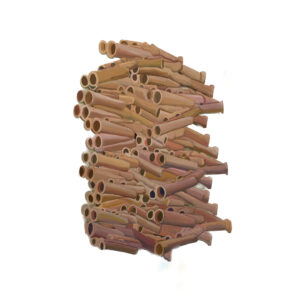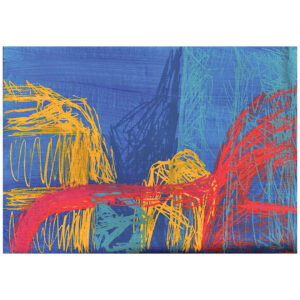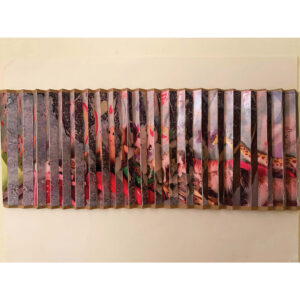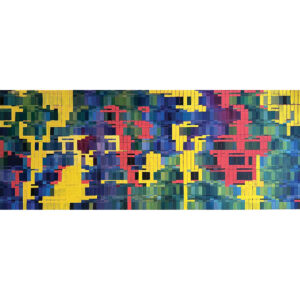Currently Empty: ₨0.00

The show titled ‘Ode to the Ordinary: An Uncommon Dialogue’Curated by Nurayah Sheikh Nabi features the works of seventeen fine art graduates from the class of 2023 at the Indus Valley School of Art & Architecture.
Venturing out on a journey of self-discovery and introspection, the young artist contemplates the complexities of existence and their intricate connections with the world around them. Each exploration acts as a window, offering insights into the multifaceted nature of our reality, with its diverse and often contradictory truths.
Through embroidery, Ahwar Nasir captures fragmented memories and emotions from diverse homes, crafting abstract visuals in pastel tones that evoke comfort and confusion. By meticulously cutting and contrasting fabric, she juxtaposes it with arbitrary, asymmetrical drawings to bring order to the chaos of her nomadic existence. Through her work, the artist explores the complex interplay between memory, emotion, and the fleeting nature of home.
“Notes from Her Bathroom” is a collaborative project exploring the concept of privacy within the confines of the bathroom and the sense of solace it provides for Alizeh Afzal & Maham Qureshi. In the spring of 2023, Maham invited Alizeh to witness and document a performance art piece held in her bathroom, marking the beginning of a series of similar events spanning a year. Through these performances, the artists discovered how the act of inviting and being welcomed into this private space fostered themes of friendship and intimacy. Together, they reflect on moments from the performances that evoke memories of their individual and shared pasts. Through this collective recollection, they uncover parallels between the performances and their personal experiences, allowing for a deeper exploration of their intersecting timelines.
In her artistic practice, Ayesha Jamal utilises not only photography and drawing but also the dynamic medium of paint. Often overlooked by many, ordinary pipes have become her canvas. As she immerses herself further into this creative exploration, she has come to realise that these pipes are not merely utilitarian objects; they boast distinctive shapes and patterns. Depending on the concept behind each piece, she integrates a range of materials including wood, paper, and imagery to bring her vision to life.
Ayla Nusrat Farook’s artwork features chaotic, intertwining lines rendered in bold red, yellow, and blue hues. The dynamic energy of the composition is palpable as if the colours are engaged in a lively dance. The central theme appears to revolve around inner turmoil within interior spaces. The overlapping lines evoke emotions that are often suppressed—perhaps feelings of confinement, restlessness, or even vulnerability. By inhabiting another’s private domain, we confront our own chaotic mental state, and this painting captures that tension beautifully.
Hamda Imran’s artwork focuses on the transition from the bustling streets to the sense of comfort found in private spaces, particularly within the crowded metropolis of Karachi. She explores this concept by photographing objects that symbolize this shift and evokes the essence of each environment. By layering different elements, she creates a motif that captures the liminal space, encouraging viewers to linger in the moment of transition. The repetition and movement in her pieces underscore the everyday nature of this experience and our enduring connection to it at the end of a busy day. The repetitive nature of the pattern has its aesthetic appeal and can communicate a message of unity. The work harnesses the inherent appeal of symmetry to create an artwork that is visually balanced and emotionally resonant.
Using printmaking techniques like woodcut and image transfer, Eman Ahmed metaphorically depicts the experience of loss by memorialising the floral patterns found in carpets and upholstery textiles that once belonged to her father. She explores grief as a process of transition, from initial bereavement to eventual acceptance, examining how the preservation of these carpets serves as a means of holding onto memories. The carpets become vessels for accumulated loss, bearing both material and emotional significance rooted in domestic and historical contexts, evident in their tactile imperfections and damage.
Through this abstract collage composed of vertically aligned, irregularly shaped strips, Javeria Aziz presents a mix of textures, colours, and indistinct forms. In her artistry, she employs the lenticular technique to blend two separate images seamlessly. These images represent contrasting perspectives that, when brought together, tell a unified narrative. Through this method, she seeks to delve into the profound impact of domestic upbringing, especially the lasting effects of being raised in a structured environment on one’s adult life.
Kainat Waseem confronts the dullness of the traditional roles of a daughter, wife, and mother, as dictated by a patriarchal society. Her art initiates a dialogue with the commonplace consumer items that fill the home. With acrylics, she methodicallys paint their outlines on canvas, each mark intentional and meaningful. In doing so, she explores the irony of their triviality within the private, yet shared, areas of her dwelling. In the quietude of daily life, her artwork reflects the dynamism that embodies her expression.
Through her assemblages, Maira Husain crafts unconventional and eccentric characters that illuminate various dramatic scenarios in Pakistan, where power dynamics are at play—such as in theater, media, political rallies, protests, and street performances. To breathe life into these characters, she meticulously curates objects that capture her attention during routine visits to the market. These objects range from rusty and discarded items to those in pristine condition, each serving as a portrait of individuals in everyday spectacles. Through strategic transformations and a touch of absurd humor, these objects undergo a metamorphosis, assuming new identities that prompt viewers to contemplate societal dynamics within our culture.
Manoj Kumar Khatri’s artistic focus centers on envisioning spaces depicted in Hindu mythology, particularly those narratives where intricate details are often omitted, leaving only descriptions of characters and dialogue. To enrich his understanding, he conducts literary and on-site research, exploring existing temples and their associated narratives for inspiration. While drawing on paper aids in his research and intentions, it lacks the cultural and spiritual depth of the myths that inspire him. Therefore, he seems to be exploring the translation of visuals from paper to fabric through embroidery, aiming to understand how this transformation alters the context and impact of the drawing and installation. For instance, “Samudra Manthan” unfolds on the boundless sea known as “Kshira Sagara” (Sea of Milk), where Devas and Asuras engage in churning the sea to extract magical substances.
Sadia Zia’s work sheds light on why women in our society are frequently reduced to mere vessels and aren’t revered for their true worth. Through her work, she probes the dilemma of consistently objectified while their inherent strength and resilience often go unnoticed and uncelebrated. It’s a reflection of the deeply ingrained gender norms and societal expectations that prioritize women’s appearance and perceived desirability over their accomplishments, abilities, and inner strength. This disparity highlights the need for a cultural shift towards valuing women for their multifaceted identities and contributions, rather than reducing them to narrow stereotypes and roles dictated by patriarchal standards.
Sami Siddiqui’s artistic narrative is about a seemingly unassuming object, the thumbtack. Enlarging this small item reveals its significance beyond its practical use, serving as a tangible representation of our innate human instinct to leave a mark and establish a presence in physical spaces. The thumbtack symbolizes the need for control and organization. Its role in securing and displaying posters, cards, and notices also introduces themes of communication and connection.
Samina Hassan Laghari’s exploration delves into the ecological impacts on her ancestral land, which has endured devastation and reconstruction multiple times due to climate-related disasters such as droughts and floods over the past two decades. Through meticulous research, she documents the evolving landscape of her village using satellite maps. Her visuals depict the remnants of continuous erasure: once vibrant greenery and lush forests that harbored diverse species, are now disrupted by ecological displacement caused by unseen forces. The river once a symbol of natural grace, now bears witness to the upheaval wrought upon the environment.
Syeda Yumna Fatima captures the significant transformations in the landscape over the past five years around the Northern areas of Pakistan. She documents these changes and compares them to previous years, sparking her curiosity about the evolving scenery. The picturesque images of the Northern areas of Pakistan once used to adorn rooms, no longer retain their former allure. In her artistic practice, she employs a method of fragmentation, as if these once-beautiful scenes have shattered into pieces.
Tahura Kamran’s work focuses on the scorching heat of Karachi. Amidst the relentless sun and limited greenery, one can engage in plant observation during the tranquil hours of dusk and dawn. During these moments, the cityscape is transformed, as neglected trees and well-tended hedges take on a spectral quality, their forms and colours shifting with the changing light. It’s a haunting sight, witnessing the city’s vegetation come to life in the soft glow of twilight and the gentle hues of sunrise. These fleeting moments offer a unique opportunity to appreciate the resilience of nature amidst the urban hustle and bustle, highlighting the beauty and fragility of Karachi’s green spaces.
Zoha Masood’s artistic practice is deeply rooted in her family’s connection to heirloom objects. These ornamental items have become an integral part of the family’s history, akin to cherished relatives. They embody human tendencies, from the inclination to accumulate old and dysfunctional possessions to the desire to preserve their sentimental and monetary value. Through the process of painting, she takes a glimpse into the past as her canvas serves as a platform for dialogue, intertwining memories and narratives associated with these depicted heirlooms.
Caption
Ahwar Nasir, “I get caught.” – 2023, Graphite and color pencils on Canson, 12.7 x 17.2 inches
Ayesha Jamal, Untitled, 2024, Oil paint on Lassani wood, 72 x 48 inches
Zoha Masood, Red Toast, 2024, Oil on Canvas, 12×16 inches
Alizeh Afzal & Maham Qureshi, notes from her bathroom (part 2) – 2024, Zine, laserjet prints on paper. (10 editions), 5.5 x 7.5 inches
Ayla Nusrat Farook, Untitled, 2023, Acrylic on Canvas, 6 x 10 inches
Hamda Imran, inbetween – 2024. Single channel video animation, 30 minute with sound, on loop, Still from the video
Javeria Aziz, Untitled – 2024, Lenticular print, 10 x 24 inches
Iman AhmedDarya Paar Bagh, Woodcut and glue-based image transfer on wood panel, 32 X 24 inches
Kainat Waseem, I kill mosquitoes everyday (a) – 2024, Acrylic on Canvas, 120 x 48 inches









